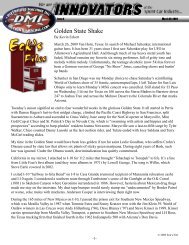DMI BULLDOG REAR - Diversified Machine Inc
DMI BULLDOG REAR - Diversified Machine Inc
DMI BULLDOG REAR - Diversified Machine Inc
Create successful ePaper yourself
Turn your PDF publications into a flip-book with our unique Google optimized e-Paper software.
TECH SPECS<br />
88 ½-40 J & J 2 " Split<br />
RF RR-23.5-1.125<br />
LF RR-23.5-1.125<br />
RR RR-24-1.000<br />
LR RR-23.5-1.000<br />
Panhard RR-19-1.125<br />
TieRod RR-45.5-ST<br />
DragLink RR-505-ST<br />
RR Arm SRC-2694<br />
LR Arm SRC-2695<br />
Jacobs Ladder SRC-2505<br />
88-40 Coil Front Non-Wing F5<br />
RF RR-24-1.125<br />
LF RR-24-1.125<br />
RR RR-34.5-ST<br />
LR RR-34.5-ST<br />
Panhard RR-21.5-1.125<br />
TieRod RR-48-ST<br />
DragLink RR-50-ST<br />
RR Arm SRC-2683<br />
LR Arm SRC-2684<br />
Jacobs Ladder SRC-2505<br />
Right Front Anti-Rollbar Arm SRC-2122A<br />
Left Front Anti-Rollbar Arm SRC-2122<br />
Anti-Rollbar Stop SRC-2121<br />
Squaring the Rear Axle:<br />
There are many different ways to square the rear end<br />
depending upon mechanical preference and comfort. This<br />
is one popular technique utilized by many professional<br />
teams. Place the rear end in the chassis and bolt up the<br />
torque tube. Set the axles on 6" blocks if it’s a standard<br />
chassis, 5" on the left side and 6" on the right if it’s a raised<br />
rail car. Secure the birdcages with spacers and the wheel<br />
nuts. Measure the distance from the rear round machined<br />
portion of the torque tube to the outer edge of the chassis<br />
by placing a straight edge vertically against the frame.<br />
Center the rear end by equalizing this distance on both<br />
sides of the car. This distance should measure between 10<br />
1/8" and 10 ¼". Now with the rear centered side-to-side,<br />
start with the right side and measure from the leading edge<br />
of the rear axle to the front edge of the motor plate. On a<br />
39" car this measurement is 37 5/8", 38 5/8" on a 40" car.<br />
Roll the axle forward or back on the blocks to achieve the<br />
correct distance. Once you have secured that distance on<br />
the right side check the left side. Ensuring that the rear is still<br />
centered in the frame and the right side measures correct,<br />
the left side may vary by as much as 1/8". This is generally<br />
left to lie as is. With the radius rods connected, place a level<br />
on the flat bottom portion of each bird cage and adjust the<br />
rods so that each cage is level with the bottom frame rail.<br />
Now bring your rear arms up to each bird cage flag and<br />
adjust each rod end so that the lower bird cage bolts slide<br />
freely through the cage and the rod end. Having completed<br />
this, recheck all of your measurements to ensure that<br />
nothing was moved during the previous processes. If all<br />
measures correct bring your jacobs ladder to the rod end<br />
or clevis and adjust the rod end or clevis in or out so that<br />
the bolt also slides freely. With these operations complete<br />
check your work by ensuring the torque ball is free and the<br />
jacobs ladder is not bound. Now you are ready for race<br />
height setup blocks and stops.<br />
Squaring the Front Axle:<br />
Set the front axle on 4" set-up blocks, or 3" and 4" if it<br />
is a raised rail car. Offset the axle 1" to the left side by<br />
adjusting the sway bar. This gives clearance to the left front<br />
torsion arm and combo steering arm. Measure 14" from<br />
the center of the right front torsion tube to the center of<br />
the axle on both sides. After roughing in the radius rods to<br />
this measurement, measure from the leading edge of the<br />
rear axle (still on 6" blocks) to the rear edge of the front<br />
axle on the rightside. After having gained this measurement<br />
we will set the lead. Check the left side the same way and<br />
adjust the rod length so that the left measurement is equal<br />
to or up to ¼" set back depending upon driver preference<br />
and size of track. With the axle now square we can adjust<br />
the caster. Place an angle fi nder on the right front steering<br />
arm. Adjust the top right front radius rod so that the angle<br />
reads anywhere from 6 to 10 degrees. Again this is driver<br />
preference, some drivers like more positive feel in the front<br />
end than others. With this complete you can drop the axle<br />
down to race height set-up blocks and adjust the stops.<br />
Don’t forget to set the tow. An 1/8" of tow out is generally<br />
the norm.<br />
(Information provided by Maxim Chassis)<br />
112 diversifiedracing.com • (717)397-5347 • bulldogrears.com



